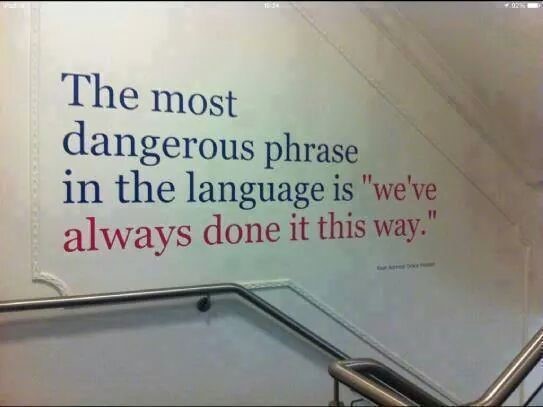From Guest Blogger Mary Beth Nelsen
I had just finished a 3-day training program. My husband asked what in the world could require three whole days. Thinking he was actually interested, I began to explain the process, including skills development, change management, practice, gaining buy-in, coaching, feedback, etc.
His eyes had already glazed over, but one thing caught his ear. “Gaining buy-in? That’s simple.” He held out one hand. “Here’s your paycheck.” He held out the other hand. “Here’s your job. You want the paycheck? Do your job.” His training programs are very brief. The message is clear. But when change is involved, it’s not that simple.
In general, people don’t like change, even if the change is innocuous, like a new wrapper on a favorite candy bar. “What was wrong with the old one?” We like things to remain familiar.
When the change involves habits or behaviors, the resistance and frustration increases. Map out a new route to work. Reduce the file size of a JPEG. Find the peanut butter in a reorganized kitchen. Master social media. Find a favorite show using a new content provider. Ask Alexa?
The same holds true when the changes are taking place at work.
 I’m convinced that every business has a sign somewhere that reads, “Because We’ve Always Done it That Way.” Many employees think it’s the company motto. There may also be a companion sign, “That’s the Way ___ Did It.” (Fill in the name of a former and possibly long-dead CEO who had a cult following.)
I’m convinced that every business has a sign somewhere that reads, “Because We’ve Always Done it That Way.” Many employees think it’s the company motto. There may also be a companion sign, “That’s the Way ___ Did It.” (Fill in the name of a former and possibly long-dead CEO who had a cult following.)
Effective change management is a process. People need to understand why the change is important and necessary- to the company, and to them personally. They need the tools to succeed- training, coaching, reinforcement, recognition and rewards. They also need to know that everyone is on board and rowing in the same direction. The last key to effective, sustained change is accountability.
To illustrate my point, let’s take a look at the story of Mary.
Safe Boating
There’s something about Mary.
Mary was a dedicated, long time employee, hired for her technical skills. She was well-liked by customers and co-workers. She got excellent performance reviews and was rewarded with regular pay raises. Her company had a very good share of the local market, but Mary’s industry began to undergo significant changes that dramatically changed the nature of their business. The company needed to develop a new approach to attracting and retaining its customers. The new approach required, among other things, new skills.
Mary’s company understood that they needed to evolve if they were to survive and thrive in this new environment. They determined what changes needed to be made, explained the changes to their employees and brought in a consultant to train the new skills.
Mary’s job changed. So did her job description. But Mary wasn’t sold on the need to change what she’d been doing so well for so long and wasn’t sure she could. She attended the training but opted out of using the new skills. She stuck with what was comfortable.
Mary’s boss was frustrated. She knew that Mary knew what she should be doing, but Mary wouldn’t do it.
I was that consultant. When I asked what was being done to get Mary on board, I got a lot of excuses.
It was mentioned in her review, and she got a smaller raise.
A smaller raise, for not doing her job.
She’s been spoken to.
That’s the extent of the consequences?
She’s doing a few of the new things.
She’s doing part of her job.
I observed that Mary didn’t have to change, as there were no consequences for opting out. At least none that bothered her enough to make the necessary changes.
“So, what are we going to do? Fire her? She’s been a good employee, with us for a long time, and is going to be retiring in 5 years, anyway.”
Five years. So for the next five years, everyone else is going to be rowing in sync, keeping the company boat afloat and moving forward, while Mary drags her oar in the water? Or worse, starts drilling holes in the boat?
How is that fair to everyone else? Mary’s not only not helping, she’s hurting. It’s unfair to the other employees to allow someone to get paid to not do what is necessary for the company’s stability and growth. What about the example it sets when Mary gets away with not doing the job that needs to be done? Pretty soon, you have more oars dragging. Going out of your way to be extra nice to good old Mary, you’re hurting the employees who are really trying. And you’re hurting your business.
 Mary is a type of highly disengaged employee. Not only is she not helping, she’s actively hurting. McLean & Company has estimated that an individual disengaged employee can cost a company up to $3,400 per year for every $10,000 of salary. And they’re contagious. Next thing you know, your boat is full of holes.
Mary is a type of highly disengaged employee. Not only is she not helping, she’s actively hurting. McLean & Company has estimated that an individual disengaged employee can cost a company up to $3,400 per year for every $10,000 of salary. And they’re contagious. Next thing you know, your boat is full of holes.
What should you do about Mary? I had a version of Mary in a class, and I will share her wisdom in her own words:
“At first I thought, who the hell are you, coming in here and telling me my perfectly excellent skills are no longer valid? Then I thought, well, it really isn’t anybody’s fault the industry changed. So, I guess I have two options: One is to take advantage of the company’s willingness to provide training and coaching and develop new job skills. Option 2 is to go somewhere else, where my skills are better appreciated!”
Key takeaway here? There cannot be an Option 3, where an employee decides not to learn and use new skills, but will continue to show up every day, be unhelpful and collect a paycheck.
As for my version of Mary, she decided on Option 1, and turned out to be key to her company’s success as both a worker and a role model. She was willing to change. A CEO who oversaw many mergers and acquisitions in his career noted that the people who are ultimately successful are those who were willing and able to change, with willingness the key.
How do you manage a Mary? First she needs to know why the changes are important, to the company, to her. Once you’ve provided skills training, focus on supporting her through strong coaching to master the new job knowledge and skills. People often resist change because they are afraid they won’t be able to succeed.
Accountability is critical. She needs to know there is no Option 3. Give regular feedback. Praise success and address challenges. Make sure rewards and/or performance improvement plans are properly aligned. (Tip: A smaller raise for not doing a key part of one’s job is still a raise. What is the message?)
How many Marys are dragging the oars on your boat? What’s your plan?
 Through her business The Right Resource, Mary Beth Nelsen brings over 25 years of experience as an outcome-focused professional development consultant and coach. Her passion is helping people and organizations realize their best potential by developing people’s business communication skills to meet business needs. She specializes in leadership development, communication, coaching, generations in the workforce, essential management skills, change management and employee engagement. Working in partnership with her clients, she focuses on integrating and aligning customer, employee and organizational needs to catalyze personal and organizational change and achieve winning outcomes.
Through her business The Right Resource, Mary Beth Nelsen brings over 25 years of experience as an outcome-focused professional development consultant and coach. Her passion is helping people and organizations realize their best potential by developing people’s business communication skills to meet business needs. She specializes in leadership development, communication, coaching, generations in the workforce, essential management skills, change management and employee engagement. Working in partnership with her clients, she focuses on integrating and aligning customer, employee and organizational needs to catalyze personal and organizational change and achieve winning outcomes.
Previous experience includes administrator of the Connecticut Bankers Association School of Finance and Management, a two-year leadership development program for banking professionals, and SVP and client manager for Fairmont, a national research, training and development company. She is Chair of the Bridgeport Regional Business Council’s Women’s Leadership Council and a Board and Executive Committee member. She serves on the boards of the St. Vincent Medical Center Foundation and the Fairfield County Community Foundation’s Fund for Women and Girls’ FESP Advisory Council. She is also a Justice of the Peace and volunteers with Junior Achievement, Center for Family Justice, Sandy Hook Promise and Charlotte Bacon Acts of Kindness.
You can contact Mary Beth at mbnelsen@therightresourceusa.com.
Want to learn more? I’ve got 4 great podcasts for you
As a culture change expert who works with companies who want or need to change, I see firsthand how hard it is for people to change. I always say change is like a dramatic play, where your employees are well-versed in acting out Macbeth but suddenly they’re being asked to do Hamlet. What’s the new script? What are my lines? I don’t want to learn a new play…I like the old one! Yes, change is something I talk about a lot, because it’s a big part of what we do at SAMC. For a deeper dive, check out these four On The Brink podcasts, including my 3-step process for bringing about lasting change:
SAMC Guest Bloggers
We have a select number of guest bloggers whom we have invited to share their insights with our readers. They bring different perspectives to the challenges of change, innovation and opening new market space, recurring themes here at SAMC. Please enjoy their viewpoints and share them with others.
Resources:
From Observation to Innovation,

Andi Simon, Ph.D.
Corporate Anthropologist | President
Simon Associates Management Consultants
Info@simonassociates.net
@simonandi
Don’t miss a single episode of our On The Brink podcast!
Subscribe now
 Through her business The Right Resource, Mary Beth Nelsen brings over 25 years of experience as an outcome-focused professional development consultant and coach. Her passion is helping people and organizations realize their best potential by developing people’s business communication skills to meet business needs. She specializes in leadership development, communication, coaching, generations in the workforce, essential management skills, change management and employee engagement. Working in partnership with her clients, she focuses on integrating and aligning customer, employee and organizational needs to catalyze personal and organizational change and achieve winning outcomes.
Through her business The Right Resource, Mary Beth Nelsen brings over 25 years of experience as an outcome-focused professional development consultant and coach. Her passion is helping people and organizations realize their best potential by developing people’s business communication skills to meet business needs. She specializes in leadership development, communication, coaching, generations in the workforce, essential management skills, change management and employee engagement. Working in partnership with her clients, she focuses on integrating and aligning customer, employee and organizational needs to catalyze personal and organizational change and achieve winning outcomes.



 I’m convinced that every business has a sign somewhere that reads, “Because We’ve Always Done it That Way.” Many employees think it’s the company motto. There may also be a companion sign, “That’s the Way ___ Did It.” (Fill in the name of a former and possibly long-dead CEO who had a cult following.)
I’m convinced that every business has a sign somewhere that reads, “Because We’ve Always Done it That Way.” Many employees think it’s the company motto. There may also be a companion sign, “That’s the Way ___ Did It.” (Fill in the name of a former and possibly long-dead CEO who had a cult following.) Mary is a type of highly disengaged employee. Not only is she not helping, she’s actively hurting. McLean & Company has estimated that an individual disengaged employee can cost a company up to $3,400 per year for every $10,000 of salary. And they’re contagious. Next thing you know, your boat is full of holes.
Mary is a type of highly disengaged employee. Not only is she not helping, she’s actively hurting. McLean & Company has estimated that an individual disengaged employee can cost a company up to $3,400 per year for every $10,000 of salary. And they’re contagious. Next thing you know, your boat is full of holes.